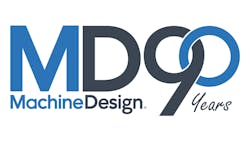As part of Machine Design’s 90th anniversary issue in January, we’ve asked industry experts to take a look at the present and future of technology and how it will impact the design and operation of manufacturing over the next decade.
Q: Before we look ahead, let’s take a look back at the last 10 years. There has been so much change, but what would you cite as one or two significant changes in the last decade?
Back: The addition of IoT capabilities in manufacturing systems has been a significant change in the last decade. By increasing data collection manufacturers are now able to monitor productivity and optimize where needed. That has changed the way companies think about increasing efficiency.
Another significant change has been the continued automation of manufacturing workflows. While automation has been a constant innovation for the past 30 years, the last decade has seen a significant growth. Removing manual processes and replacing them with automated, computer-managed systems that are conducive to overnight manufacturing has created so much efficiency for manufacturers.
Q: What’s the one technology update that every design engineer should be incorporating into their systems today? What’s the one technology upgrade that every end-user should be demanding?
Back: Every engineer should be incorporating sensors into their products and systems. Using them to create “digital twins” is changing the way manufacturers monitor their products and assets. They also further increasing data collection to provide that valuable user feedback and enabling incredible control throughout the entire manufacturing process.
Q: In areas such as AI, machine learning, and IIoT, how quickly do you think these technologies will be adopted in manufacturing?
Back: We’re proud to say that BigRep has already set the standard in IIoT for manufacturing technologies by incorporating these advanced data collection systems into the BigRep PRO with our Bosch Rexroth CNC Control system providing user feedback and essential manufacturing and maintenance information.
Q: What does manufacturing look like in 10 years? And what are some of the broad areas your company is focusing on to bring about those changes?
Back: Much wider usage of additive technology on the manufacturing floor and for end-use parts will be a reality within the next 10 years. Improving innovation cycles with shorter lead times at every phase and lower costs for manufacturing as efficient supply chain innovations like closed-loop material processes—like shredding and reusing filament—increase.
On-demand local production will further decrease environmental and logistical challenges as the need for warehouses and shipping falls.
About the Author

Bob Vavra
Editor Emeritus, Machine Design and Power & Motion
Bob Vavra is the former senior content director of Machine Design and Power & Motion.
